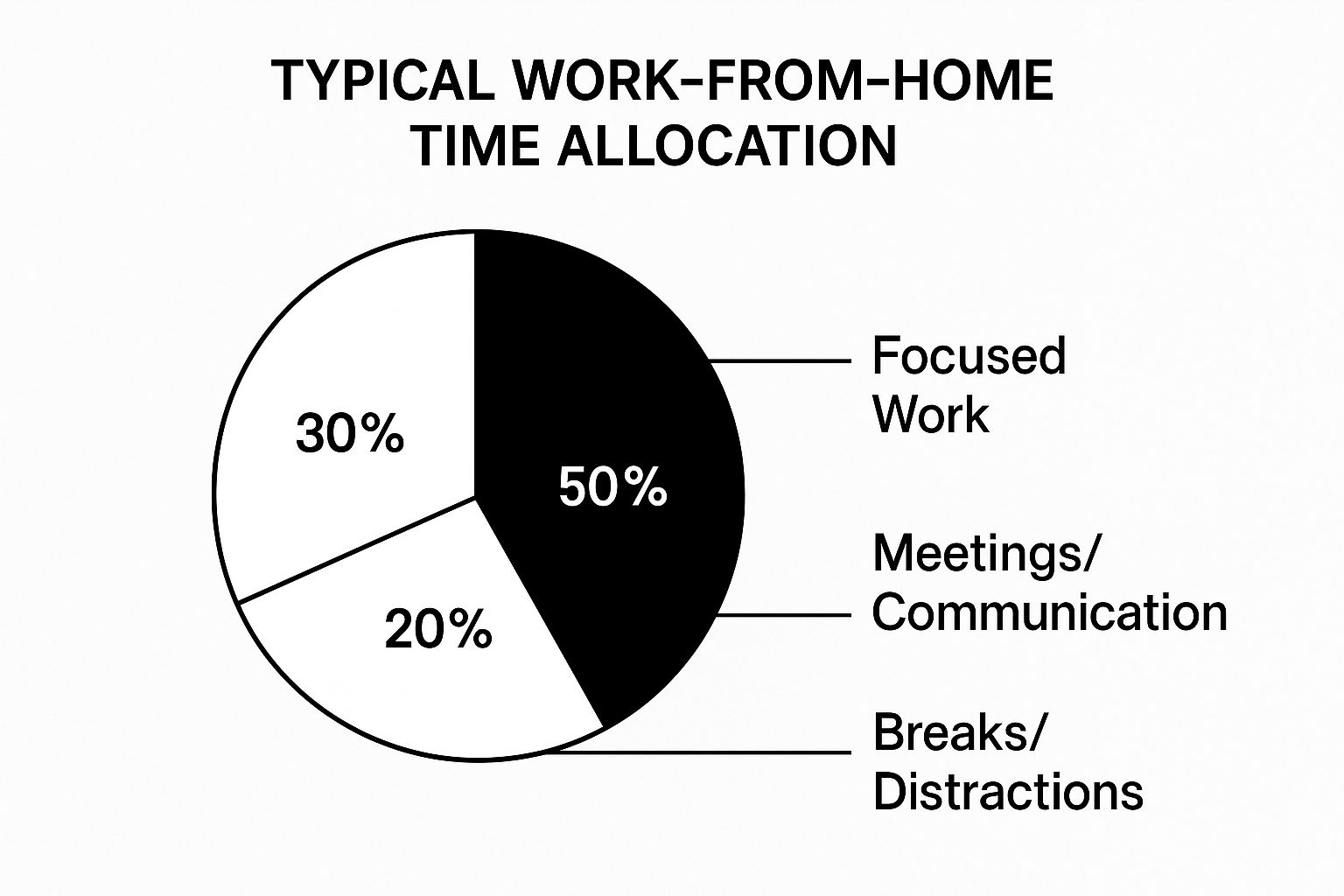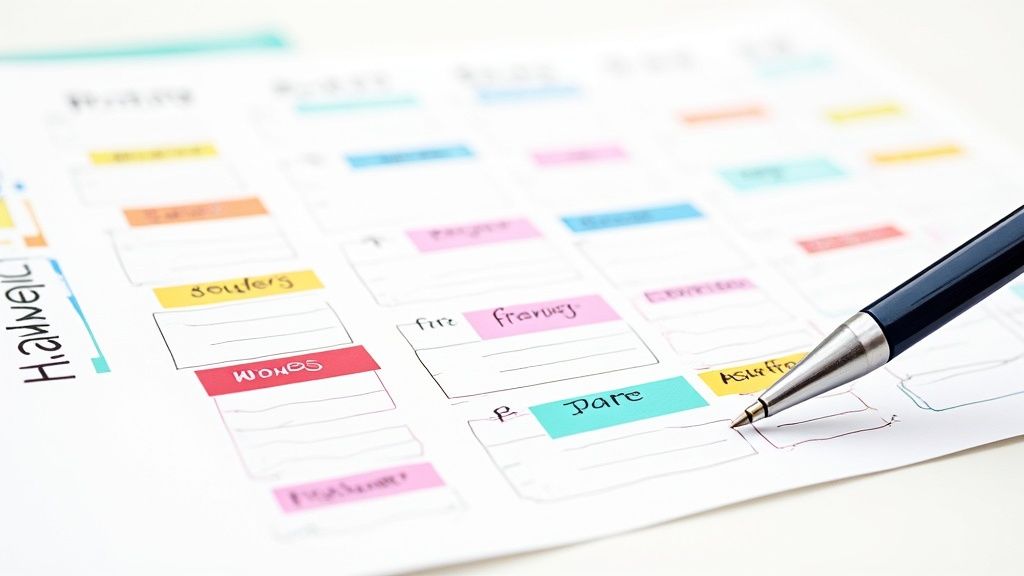
Work From Home Time Management Tips for Productivity
Published
Designing Your Home Office for Peak Time Management
Your physical surroundings have a huge impact on your mental state and, by extension, how well you manage your time. Let's be real: trying to work from a kitchen table covered in last night's mail and coffee rings doesn't exactly get the productivity flowing. Effective work from home time management starts by creating a dedicated space that tells your brain, "Okay, it's time to focus." You don't need a separate room with a door, but you do need to be intentional.
First things first, set a clear boundary. Even if you're in a tiny apartment, this can be as simple as dedicating one corner of your living room to work. The most important rule is that this area is exclusively for work. When you sit there, you're on the clock. When you leave, you're off. This mental separation is a game-changer for keeping work from spilling into your personal time.
Creating Psychological Boundaries
To make these boundaries stick, think in terms of physical and visual cues. An ergonomic chair isn't just about good posture; it's a different seat than the one you binge-watch your favorite shows from. In the same way, having a specific work monitor that you shut down at 5 PM can be a powerful signal that your workday is officially done. These small environmental triggers train your brain, making it easier to switch between "work mode" and "life mode" without the mental gymnastics.
This dedicated setup also helps you squash distractions, which is a big reason remote work can be so effective. In fact, some studies show that remote employees can be 35% to 40% more productive than their in-office counterparts, mostly because they have a more focused environment. You can dive deeper into these productivity stats and see what's on the horizon by checking out more on the future of remote work on Neat.no.
Optimizing Your Space for Focus
Once you've marked your territory, it's time to fine-tune it for efficiency. Think about the little things that steal your time throughout the day. Are you always getting up to refill your glass? Keep a large water bottle and a coaster at your desk. Wasting minutes hunting for the right charger? A simple docking station can solve that. These tiny improvements stack up, helping you protect your most precious resource: your focus.
To give you a clearer picture of how these small changes can make a big difference, here’s a look at how a basic setup compares to an optimized one.
Essential Home Office Setup Comparison
| Setup Element | Basic Setup | Optimized Setup | Time Saved Daily |
|---|---|---|---|
| Desk | Kitchen table or shared surface | Dedicated desk in a quiet corner | 5-10 minutes |
| Chair | Dining chair or sofa | Ergonomic chair | 5 minutes (fewer breaks) |
| Monitors | Laptop screen only | Dual monitors or one large monitor | 15-20 minutes |
| Accessories | Scattered chargers, no organization | Docking station, cable organizers | 5 minutes |
| Lighting | General room lighting | Adjustable desk lamp | 5 minutes (less eye strain) |
| Distraction Mgt. | Phone on desk, open tabs | Phone in another room, noise-canceling headphones | 20-30 minutes |
As you can see, optimizing your workspace isn't just about comfort; it's a strategic move that can give you back a significant chunk of your day. These small, targeted upgrades directly reduce friction and reclaim lost minutes.
The infographic below really drives home how much of our day can get eaten up by distractions if we're not careful.

This visual is a stark reminder to guard your focused work time. By designing an office that anticipates your needs and removes those tiny annoyances, you're building a fortress around your most productive hours, protecting them from the constant barrage of minor tasks and interruptions.
Creating Routines That Work With Your Real Life
Let’s be real: those "5 AM miracle morning" routines you see all over social media are a fantasy for most of us. They don't account for kids, pets, or the general chaos of life. In the world of influencer marketing, a rigid schedule is bound to fail before you've even had your first coffee. The key to effective work from home time management isn't about forcing a perfect, color-coded plan. It's about finding a flexible rhythm that actually fits your life.
This all starts with a little self-awareness. Are you a morning lark who can draft creative briefs while the rest of the world is still asleep? Or do you find your focus in the afternoon, after the morning rush is over? Working with your natural energy levels—not fighting them—is the first real step to building a routine that lasts. For instance, if your brain is sharpest from 10 AM to 1 PM, guard that time for your most demanding work, like campaign strategy or content ideation. Save the administrative tasks and less urgent meetings for your lower-energy periods.
Building Your Morning and Evening Rhythms
A solid routine is held up by consistent morning and evening bookends. I'm not talking about hour-long, complicated rituals. Think small, repeatable actions that signal to your brain when the workday begins and ends.
- Morning Kick-start: Before you even think about checking emails from your bed, create a simple five-minute "commute." This could be anything from enjoying your coffee on the porch, taking the dog for a quick walk, or doing a few stretches in a different room. The goal is to create a mental separation between your personal time and work time.
- End-of-Day Shutdown: This is the one step everyone skips, but it's a game-changer. Dedicate the final 10 minutes of your workday to planning for the next. Straighten up your desk, jot down your top three priorities for tomorrow, and then completely shut down your work computer. This small act provides a sense of closure and helps you properly switch off.
The Power of Planned Flexibility
Life is unpredictable. A client might have a last-minute request, your Wi-Fi could decide to take a nap, or a family member might need you. A truly effective routine is designed with this in mind. This is where taking strategic breaks becomes essential. Understanding the vital role of taking breaks at work is fundamental to staying productive and avoiding burnout. A quick walk outside or a 15-minute break away from your screen can do wonders for your focus—much more than just trying to power through the fatigue.
Your routine should serve you, not the other way around. When designed well, it feels less like a set of rules and more like a supportive framework that keeps you on track, even on the most hectic days. If you're looking for roles that value this kind of autonomy, check out our guide on how to get a remote job for plenty of opportunities.
Mastering Flexible Scheduling Without Losing Control
 The freedom to build your own schedule is one of remote work’s greatest perks and, let's be honest, one of its biggest headaches. Without the daily routine of an office, your days can easily dissolve into a chaotic mix of competing tasks. For influencer marketing pros, managing your time from home isn't about locking yourself into a rigid schedule; it's about building a flexible framework that keeps you focused on what truly matters.
The freedom to build your own schedule is one of remote work’s greatest perks and, let's be honest, one of its biggest headaches. Without the daily routine of an office, your days can easily dissolve into a chaotic mix of competing tasks. For influencer marketing pros, managing your time from home isn't about locking yourself into a rigid schedule; it's about building a flexible framework that keeps you focused on what truly matters.
This way of working isn't a niche trend anymore. Since 2020, the number of remote jobs in the U.S. has tripled. By 2025, it's predicted that 22% of the American workforce will be fully remote. This huge shift means more of us are trying to solve the same scheduling puzzle. You can get a deeper look at these changes by exploring insights on remote work trends from StrongDM.
Embrace Time Blocking, Not Time Tracking
Forget about trying to account for every single minute of your day—it's exhausting and often counterproductive. A much better method is time blocking, which involves dedicating specific chunks of your day to related types of tasks. This isn't a strict, hour-by-hour plan but more about creating dedicated zones for different kinds of thinking.
Here’s how a typical day could look for someone in influencer marketing:
- 9 AM - 11 AM (Creative Block): This is your time for deep, focused work. Use it for campaign brainstorming, writing creative briefs, or editing video content. No emails, no DMs, no calls. Protect this time fiercely.
- 11 AM - 1 PM (Communication Block): Grouping all your communication into one block is a game-changer. This is when you tackle your inbox, respond to DMs, and take scheduled calls with clients or influencers. It prevents constant interruptions from derailing your focus.
- 2 PM - 4 PM (Execution Block): Save this block for the "doing" parts of your job—scheduling social media posts, pulling campaign analytics, updating performance trackers, and managing outreach lists. These tasks are important but require less creative energy.
Setting Clear Availability Boundaries
Your flexible schedule is worthless if clients and colleagues assume you're on call 24/7. It's vital to communicate your core working hours clearly. A great tip is to add your "Communication Block" hours to your email signature and update your status on team chat apps like Slack or Microsoft Teams.
A simple status like "Deep Focus until 2 PM" works wonders. It manages expectations without you having to actively decline messages. This one small action helps you reclaim your focus and teaches others to respect your workflow, giving you the structure needed to do your best work.
Building Communication Systems That Save Time
We've all been there: a project that should be simple gets bogged down in a swamp of vague messages and endless back-and-forth emails. For influencer marketing pros, where things move at the speed of a viral TikTok, these communication breakdowns are huge time thieves. A core part of mastering work from home time management is getting intentional about how you and your team actually talk to each other. It’s not about being available 24/7; it's about setting up clear, predictable ways to interact.
The first step is to break free from the "let's just hop on a call" default. Before scheduling anything, pause and think about the goal of the communication. Is a 30-minute video call really necessary, or could this be a quick message? Choosing the right tool for the job is a game-changer.
The Right Tool for the Right Task
Having a simple framework for communication can slash the number of pointless meetings and keep everyone on the same page without constant interruptions. Think of it as a communication hierarchy:
- For project updates and general questions (Low Urgency): Use a project management platform like Asana or Trello. This is for anything that doesn't need an immediate response. It allows your team to check in and reply when it makes sense for them, protecting precious blocks of deep-focus time.
- For quick questions that need a fast reply (Medium Urgency): This is where chat tools like Slack or Microsoft Teams shine. A message like, "Can anyone confirm the brand's Instagram handle for this post?" is perfect for chat. It gets a quick answer without derailing anyone's workflow.
- For brainstorming and complex issues (High Urgency/Complexity): Save video calls for the heavy lifting—brainstorming new campaign ideas, hashing out complicated feedback, or solving a critical problem that's popped up. My personal rule of thumb: if it’s going to take more than three back-and-forth messages to sort out, it's time for a call.
To give you a clearer picture, let's break down how different tools can affect your daily schedule and overall output.
| Tool Type | Time Saved per Day | Best Use Case | Productivity Impact |
|---|---|---|---|
| Project Management (Asana, Trello) | 45-60 minutes | Assigning tasks, sharing campaign briefs, tracking progress, non-urgent questions. | High: Creates a central source of truth, reducing "where do I find..." questions and status update meetings. |
| Instant Messaging (Slack, Teams) | 20-30 minutes | Quick clarifications, sharing links, confirming small details, urgent but simple questions. | Medium: Speeds up simple decision-making but can be disruptive if not used with clear etiquette (e.g., using threads). |
| 15-20 minutes | Formal external communication with brands or influencers, sharing final reports, official documentation. | Low: Slow response times make it inefficient for internal collaboration. Best reserved for formal, external comms. | |
| Video Calls (Zoom, Google Meet) | 30-45 minutes (by avoiding unnecessary ones) | Complex brainstorming, performance reviews, sensitive conversations, campaign kick-offs. | Variable: Extremely effective for complex talks but a major time drain when used for simple status updates. |
This table shows it's not about ditching one tool for another but using each one for what it does best. By directing communication to the right channel, you cut down on noise and give your team more time to focus on what really matters.
The Foundation of Trust and Clarity
At the end of the day, an efficient communication system runs on trust. When you trust your colleagues to be reliable and handle their responsibilities, the need for constant check-ins disappears. An analysis of over 1.3 million employees discovered that when people trust their colleagues to cooperate, they are 8.2 times more likely to give extra effort.
This is the secret sauce for effective asynchronous work. You can log off knowing your team is moving forward, because there's a system in place that works. If you're curious about how top-performing companies achieve this, you can learn more from this study on the surprising reality of remote work productivity. By setting up these clear systems, you're not just saving a few minutes here and there—you're building a more collaborative, effective, and less stressful remote team.
Conquering Remote Work's Biggest Time Wasters

It's time to get real about the biggest threats to your productivity: the sneaky time-wasters that just love a remote work setup. The freedom of working from your own space can easily become a constant struggle against a thousand tiny distractions, from the pile of laundry in the corner to the siren song of your social media feed. Nailing work from home time management means you have to identify these productivity drains and have a game plan to shut them down.
Let's start with a classic: household chores. When you're wrestling with a tough campaign brief, the urge to suddenly empty the dishwasher can feel overwhelming. This isn't just you procrastinating; it's your brain looking for a quick, easy win. The trick isn't to let your home fall into chaos but to schedule these tasks. Set aside a specific, non-work block of time—like your lunch break—to tackle one or two quick chores. This keeps the distraction contained and gives you that satisfying sense of accomplishment without derailing your entire workday.
Taming Digital and Mental Distractions
Another black hole for your time is the constant barrage of digital pings and dings. That one little notification can instantly snap you out of deep, focused work. Since social media and other digital alerts are known time sinks, it pays to have specific strategies to manage them. You might find it helpful to explore some dedicated social media time management strategies to really get a grip on your day. Simple moves like turning off non-essential notifications or using an app blocker during your core work hours can make a world of difference.
Finally, let’s address the mental time-wasters: loneliness and a lack of structure. When you feel isolated, it’s all too easy to drift and put things off. A great way to counter this is by creating a sense of accountability.
- Start a focus group: Find a colleague and set up a virtual "power hour." You both get on a silent video call, share what you plan to accomplish in that hour, and then just work. The simple act of another person being "there" can be a powerful motivator.
- Declare your intentions: Just telling your partner or a friend your main goal for the day can make you more likely to see it through.
Learning to deal with these distractions head-on is a critical skill. If you're currently interviewing, showing that you can manage these challenges is a huge plus. For more on this, check out our guide to common remote job interview questions. The idea is to build a system that protects your focus, turning potential distractions into just another managed part of your day.
Tracking Progress and Optimizing Your Approach
You've probably heard the old saying, "what gets measured gets managed." While true, in the world of remote work, it's incredibly easy to fall into the trap of analysis paralysis. Becoming obsessed with tracking every single second can be more draining than the work itself. The real magic of effective **work from home time management** isn't just about tracking; it's about paying attention to your habits and making small, intelligent adjustments along the way.Instead of getting tangled up in complicated spreadsheets, try a simple, honest weekly review. This isn’t a moment to judge yourself, but a quick mission to gather some personal data. Set aside 15 minutes every Friday afternoon to reflect on your week and ask yourself a few pointed questions.
Conducting a Quick Weekly Audit
A weekly audit is a low-effort, high-impact way to spot patterns and stay on track without needing any fancy software. Just grab a notebook or open a doc and jot down your thoughts on these prompts:
- What was my biggest time-waster this week? Be honest. Was it getting pulled into long email chains that could have been a single message? Or maybe it was the siren call of household chores during what was supposed to be your focus time.
- When did I feel most productive and focused? Try to pinpoint the exact day and time. Maybe it was that quiet Tuesday morning before your first meeting. This helps you identify and protect those "golden hours."
- What one task, if I had done it earlier, would have made the week run smoother? This question is great for uncovering opportunities to prioritize better next week.
Answering these questions consistently week after week will give you some powerful insights. For example, you might realize you're at your most creative on Wednesday mornings, which could prompt you to move that recurring team check-in to the afternoon. Or, you might find that 80% of your "urgent" interruptions came from a single client, signaling a need to establish clearer communication boundaries.
This process of self-assessment is a bit like applying Stephen Covey's Time Management Matrix to your own life, learning to distinguish what's truly important from what just feels urgent. It’s not about finding the perfect system overnight. It’s about making one or two small, informed tweaks each week. Maybe next week, you commit to blocking off that productive Wednesday morning for deep work, no exceptions. The week after, you might experiment with checking your inbox only twice a day. These tiny, consistent adjustments are what build a time management system that is sustainable and actually works for you.
Your Personalized Time Management Action Plan
All the advice in the world is just theory until you actually use it. The real key to mastering work from home time management is to build a plan that fits your specific workflow, challenges, and even your personality. It’s about creating a personal roadmap you can stick with, not a set of rigid rules that are easy to break. This action plan is designed to be your starting point.
Your First Steps: Quick Wins for Today
Momentum is everything. Start with small, immediate changes that give you a sense of control and prove that you can make a difference in your day. These aren't huge life changes, just tiny adjustments to get the ball rolling.
- Try the 10-Minute Tidy: Before logging off, set a timer for 10 minutes. Use that time to clear your physical and digital workspace and write down your top three priorities for tomorrow. This simple ritual helps you close out the day and start the next one with a clear head.
- Silence One Notification: Think about your biggest digital distraction—is it email pop-ups, a specific chat channel, or social media alerts? Pick one and turn it off completely for a two-hour focus block tomorrow. See how it feels.
- Schedule a Real Break: Open your calendar for tomorrow and block out 15 minutes for a non-work activity. Seriously, put it on the calendar. Go for a walk, listen to a podcast, or just step away from your screen.
Medium-Term Goals: Building Habits Over Weeks
Once you've got a few quick wins under your belt, it's time to build more solid systems. Don't try to do everything at once; pick one or two of these to focus on for the next few weeks.
- Conduct a Weekly Audit: For the next three weeks, spend 15 minutes every Friday looking back at your time. Ask yourself: When was I most focused? What was my biggest time-waster? This self-awareness is gold. For more ideas on making remote work effective, these tips on how to successfully work from home are a great resource.
- Establish Communication Rules: If you work with a team, suggest a simple framework for your communication tools. For example, you could propose, "Let's use our project management tool for all non-urgent updates and keep chat for immediate questions."
Long-Term Strategy: Maintaining Momentum
Keeping good habits going is the final piece of the puzzle. This is about creating a flexible system that can change as your role and projects do. If you're looking for a role that supports this level of independence, you might find it in our list of remote influencer marketing jobs. The key is to regularly check in on your systems and adjust what isn’t working. Good time management isn't a final destination; it's a constant practice of making small, smart choices every day.
Ready to find a role that fits your new, optimized workflow? Browse the latest influencer marketing jobs on InfluencerMarketingJobs.net and discover opportunities that value your productivity and respect your time.